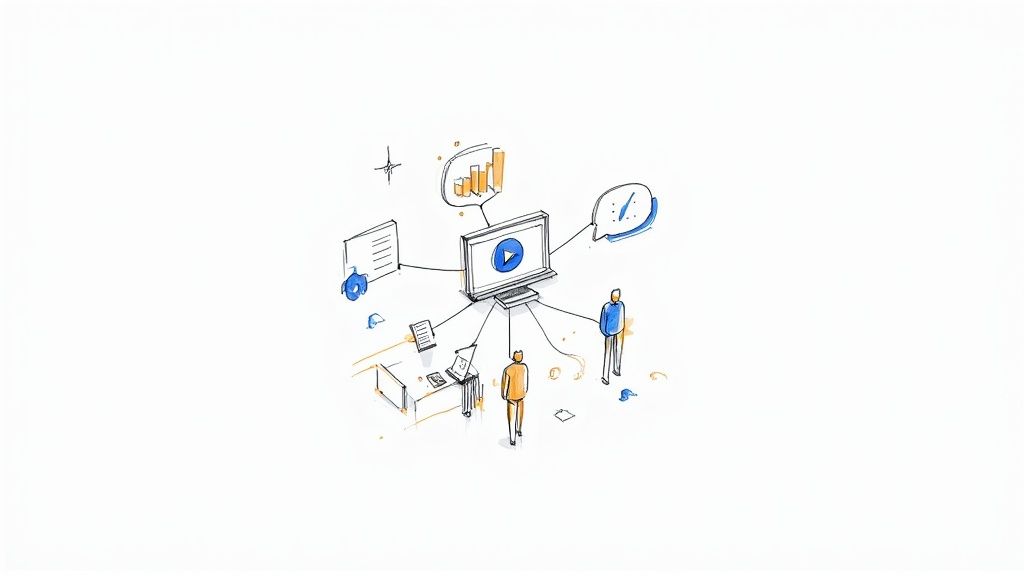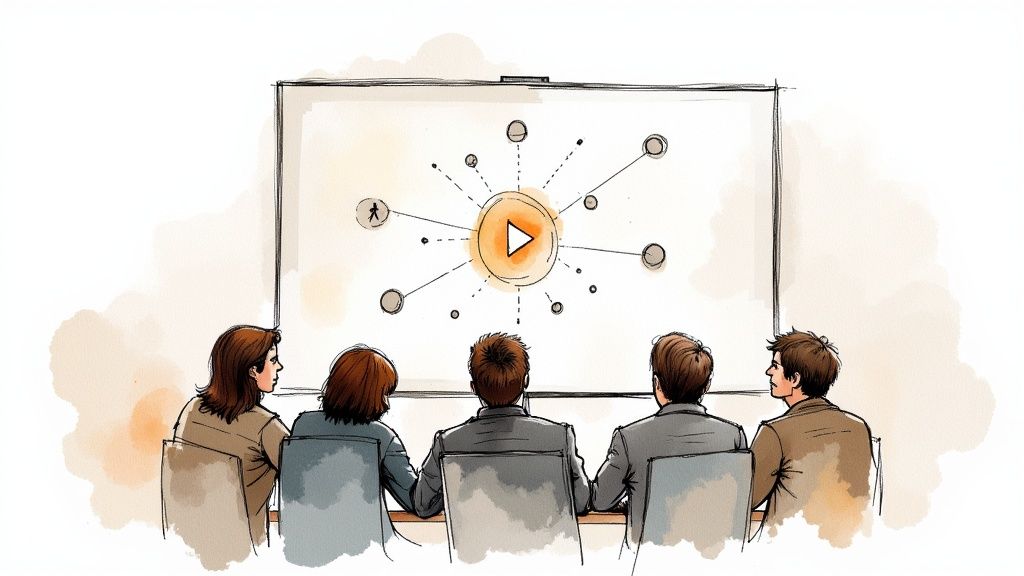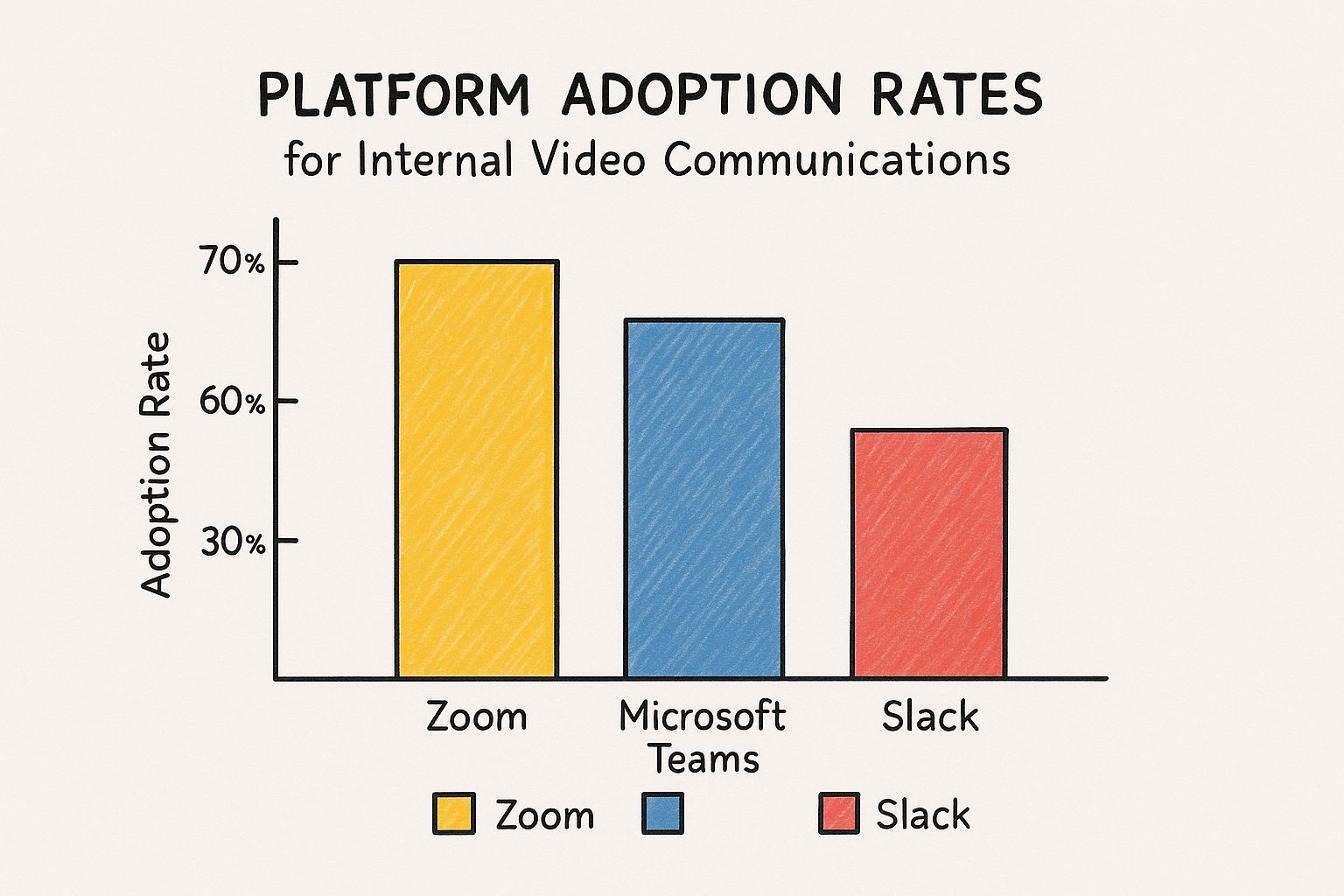
A Guide to Internal Video Communications
Internal video communications is all about using video to share information, build up your company culture, and connect employees inside your organization. It’s a move away from static, text-heavy messages like emails and memos toward something more dynamic and, frankly, more human—a way to talk with your team, no matter where they are.
From Monologue to Dialogue: The Power of Video

Think about the classic company memo for a second. It's a one-way street, a broadcast sent from the top down with zero room for a real conversation.
Now, imagine swapping that out for a short, engaging video from your CEO explaining a new company direction. You can actually see their expression, hear the conviction in their voice, and pick up on the nuances behind the message. This jump from a stuffy corporate monologue to a genuine dialogue is what modern internal video communications is all about.
With teams more spread out than ever, this approach has become a necessity. Video closes the physical distance that often leads to people feeling disconnected or getting the wrong end of the stick. It's a richer, more personal way to communicate that builds trust and helps everyone feel like they're part of the same community.
Why Video Is More Than Just a Channel
It’s easy to think of video as just another tool to add to the pile, but that's a mistake. It’s a powerful medium for making complex information easier to swallow and remember. A few great examples include:
- Leadership Updates: A video message from a leader just feels more authentic and transparent than a perfectly polished email. It’s a simple way to build trust across the whole company.
- Onboarding and Training: New hires can get up to speed much faster with visual walkthroughs and demos, helping them feel connected from their very first day.
- Company Culture: Want to bring your company's values to life? Try employee spotlights, team celebration videos, or some behind-the-scenes content.
- Major Announcements: When you need to explain a big strategic change or a new product launch, video ensures the message lands with real clarity and impact.
In short, internal video communications changes how messages are received. It helps employees not just understand the information but also feel more connected to the company's mission and its people.
Of course, video works alongside other tools, not in place of them. Recent survey data shows that while email is still a big player at 36% usage, video-first platforms like Microsoft Teams and Zoom are absolutely critical.
The data also drives home a key point: with 42% of employees working fully from home and another 19% in a hybrid setup, video is the connective tissue holding a dispersed workforce together. You can dig into the complete breakdown of these communication statistics to learn more.
How Video Strengthens Modern Company Culture

Company culture isn't just about the mission statement you frame on the wall. It’s the living, breathing result of daily interactions, shared understanding, and a feeling of connection. Good internal video communication is the catalyst here, turning those abstract values into something real and tangible for everyone.
Think about it. It’s the difference between reading that your company values transparency and actually seeing it in action.
When a leader gets on camera, they're doing so much more than just passing along information. They’re offering a window into their personality and their conviction. A carefully worded email can feel sterile, even a little distant. But a video message lets you see their facial expressions and hear the genuine tone in their voice. That human element is absolutely irreplaceable for building trust.
This connection is even more vital in remote and hybrid companies where you don't have those casual "water cooler" moments. Video bridges that physical distance, helping every team member feel seen, heard, and genuinely aligned with where the company is headed—no matter where they’re logging in from.
Weaving Culture Through Different Video Types
A vibrant company culture is built from many different threads, and specific types of video each play a unique role in weaving them all together. It’s not about just one kind of content; it's about a consistent strategy that reinforces who you are as a company at multiple touchpoints.
Just look at a few key examples:
- Onboarding and Training Videos: These videos do way more than just explain processes. They’re your first chance to welcome new hires into the fold, introducing them to teammates and company norms in a warm, personal way that sets a positive tone from day one.
- Employee Spotlight Videos: Celebrating individual achievements and personal stories makes employees feel genuinely valued. It puts a human face on the company and showcases the diverse talent that makes the organization what it is.
- Company Announcement Videos: For major updates, nothing beats a video from leadership for providing clarity and reassurance. Seeing the message delivered directly cuts down on the risk of misinterpretation that so often plagues text-based announcements.
By consistently using video to communicate, you create a powerful feedback loop. Employees feel more informed and connected, which in turn boosts their engagement and strengthens their sense of belonging to a unified team.
This approach is a direct counter to the feeling of disconnection that can silently chip away at a company's foundation. A smart video strategy doesn't just broadcast messages; it actively nurtures a real sense of community.
Fostering a Feeling of Value and Belonging
At the end of the day, the goal of using internal video communications for culture-building is to make every single employee feel like a valued part of the whole.
When an employee in a different time zone can watch a town hall meeting and see their question answered live by the CEO, it creates a powerful sense of inclusion. It's a small thing that makes a huge difference.
This strategy reinforces that the company is a collective of people, not just a list of job titles. It shows that leadership is accessible, that individual contributions are seen and recognized, and that everyone is pulling in the same direction. That consistent, human-first communication is the bedrock of any resilient and positive modern company culture.
Practical Use Cases for Internal Video
Alright, let's move past the theory. The real magic of internal video communications happens when you see it in action, solving real-world business problems department by department. This isn't about making videos just for the sake of it. It’s about using a surprisingly versatile tool to get tangible results, make things run smoother, and ensure everyone is hearing the same message.
Think of it like a Swiss Army knife for your internal comms. For the C-suite, it's a direct line to broadcast important updates with a human touch. For HR, it’s a powerhouse for getting new hires up to speed consistently. And for sales, it’s a living playbook for sharing what works.
The common denominator here is impact. Every video should have a clear purpose, whether that’s deepening employee understanding or helping teams hit their goals faster.
From the C-Suite to the Front Lines
Every single department can put internal video to good use. The trick is to match the type of video to the specific goal, creating content that people don't just watch, but actually find useful.
- Executive Communications: Leaders can ditch the stuffy, formal emails and host live or pre-recorded all-hands meetings and town halls instead. This puts a face to the company's strategy and builds a level of trust and transparency an email just can't match.
- HR and Onboarding: Imagine creating a go-to library of on-demand training videos for new hires. This ensures every single person gets the same high-quality rundown on company culture, benefits, and compliance. Plus, it frees up your HR team to focus on more strategic work.
- Sales Enablement: What if your sales team could watch a quick video of a top performer nailing a tough objection or closing a major deal? This kind of peer-to-peer knowledge sharing is gold for getting best practices to stick across the entire team. Many of the same principles for engaging external customers apply here, too. For more ideas, you can check out our guide on turning viewers into buyers with interactive videos.
When you get it right, video stops being a "nice-to-have" and becomes a core part of how your organization operates. It's a fundamental tool for keeping everyone aligned and sharing knowledge effectively.
Where Video Is Most Adopted
So, how are companies actually delivering these videos? Unsurprisingly, a few key platforms have become the go-to channels for internal video strategies.

The data here is clear: platforms like Zoom and Microsoft Teams are the heavy hitters, cementing their place as the central nervous system for video-based conversations in the modern workplace.
But here’s where things get interesting. There's often a huge gap between the communication channels that are most effective and the ones that are actually used. Recent data shows a massive opportunity for companies that are willing to look beyond the usual suspects.
Effectiveness vs. Adoption of Communication Channels
Take a look at that leader-to-employee channel—a perfect fit for video messages. It has an 85% effectiveness rating, yet only 43% of organizations are using it. Or social engagement platforms, which show 68% effectiveness but are adopted by a mere 16% of companies.
This disconnect highlights a major opportunity. By embracing these proven, video-capable channels that are currently flying under the radar, companies can dramatically improve how information flows and connects with their teams.
Driving Engagement with Interactive Video

Let's be honest, traditional internal videos can feel a bit like a one-way street. Your team hits play, watches (or half-watches), and then gets on with their day. You’re left wondering if the message actually stuck.
What if you could flip that script? What if you could turn that passive viewing into an active, hands-on experience? This is where interactive video completely changes the game for your internal video communications.
Think of it like the difference between a lecture and a workshop. One broadcasts information at people, while the other invites them to participate, ask questions, and apply what they’re learning in the moment. Interactive video does just that by embedding clickable elements right into the video player, turning viewers into participants.
Platforms like Mindstamp are designed to make this happen. Instead of just pushing a video out, you can build a whole experience around it. You get to move past simple view counts and start measuring real, meaningful engagement.
Turning Viewers into Participants
Interactive features are what give employees the power to engage directly with your content. They break that passive cycle and prompt action, creating a genuine two-way conversation. This doesn’t just make the content more memorable; it gives you invaluable data on what’s actually working.
Here are a few core features that make this transformation happen:
- Clickable Buttons and Hotspots: Imagine embedding clickable areas directly onto items or even people in your video. In a benefits overview, an employee could click a hotspot on the "Retirement Plan" section to instantly open a PDF with all the details.
- In-Video Questions and Quizzes: You can test for understanding on the spot. A compliance training video could include a few mandatory questions to make sure everyone grasps the key policies, giving instant feedback to both the employee and their manager.
- Personalized Branching Paths: Let employees choose their own adventure. In a tutorial for new software, a viewer could select their department—"Sales" or "Marketing"—and be taken down a video path with examples and use cases tailored specifically for their role.
By making video an active experience, you shift the employee’s role from a passive audience member to an engaged learner. This simple change is key to improving information retention and ensuring your internal communications have a measurable impact.
Linking Interactivity to Business Outcomes
These features are more than just clever tricks; they deliver tangible benefits that tie directly back to your company's goals. When employees are actively participating, you'll see a direct improvement in the results of your internal communications strategy.
This hands-on model drives results like:
- Higher Retention: We all know interactive learning is more effective than just sitting back and watching. When employees have to answer a question or choose their path, they are far more likely to remember the information.
- Better Engagement Metrics: Stop guessing who watched and start measuring who participated. Analytics on clicks, answers, and choices give you a much richer, more accurate picture of how effective your content really is.
- Direct Feedback Loops: Use in-video prompts to get instant feedback on a new company initiative or to collect questions for an upcoming town hall. It closes the communication loop in real time.
Interactive elements make your videos work smarter, not just harder. If you want to get into the nuts and bolts, check out our guide on how to create interactive video and start building more effective content today.
Measuring the ROI of Your Video Strategy
So, you’ve created some great videos. How do you actually prove their value beyond just saying, “people watched it”? A real internal video communications strategy needs a clear way to measure its return on investment (ROI). This means getting past surface-level data like view counts and digging into metrics that tie directly to business results.
Think of it this way: a simple view count is like knowing how many people walked past a storefront. Sure, it’s a starting point, but it doesn’t tell you who came inside, what they looked at, or if they found what they needed. To get the full picture, you have to measure what they did.
Metrics That Truly Matter
To build a strong case for your video efforts, you need to focus on metrics that show real employee engagement and changes in behavior. This is where a platform with robust analytics, like Mindstamp, becomes essential, as it’s built to capture this deeper level of data.
Here are the key metrics you should be tracking:
- Engagement Rates: This isn't just one number. It includes clicks on interactive elements, answers submitted to in-video questions, and—critically—video completion rates. A high completion rate on a mandatory compliance video, for example, is a powerful sign that it's actually working.
- Knowledge Retention: How do you prove your training videos are effective? By embedding quizzes and knowledge checks right inside the video. Tracking the percentage of correct answers gives you hard data that employees aren't just watching, but learning.
- Employee Feedback: Use interactive prompts to open up a dialogue. Ask employees what they think of a new company initiative or what questions they have for an upcoming all-hands meeting. This turns video from a one-way broadcast into a two-way conversation.
Connecting Video Performance to Business Goals
The ultimate goal is to connect these video analytics to tangible business objectives. For instance, if you can show that a new interactive onboarding series reduced the time it takes for new hires to become fully productive by 20%, you’ve demonstrated clear, undeniable ROI.
Similarly, achieving a 98% completion and pass rate on a new safety protocol video directly supports a critical compliance goal.
When you can present data showing higher employee satisfaction scores from departments that actively engage with video content, you’re no longer just talking about views—you’re talking about real business impact.
Measuring this ROI is even more critical as new technologies emerge. The 2025 Global State of Internal Communications Report found that while 77% of communicators are now using AI tools to help create video content, 60% of respondents still rate their overall employee engagement as just average. This shows that technology alone isn't the solution. You need a strategic, measurable, and human-first approach to make your internal videos truly effective. You can get more details by exploring the full 2025 internal communications report.
By focusing on the right metrics, you can shift the conversation from cost to value. This data-driven approach not only justifies your current strategy but also gives you the insights needed to constantly improve, ensuring every single video you create serves a clear and measurable purpose.
Common Questions About Internal Video
Dipping your toes into the world of internal video can feel like a big step, but it’s honestly simpler than most people think. A lot of the hesitation comes from some common myths about how much it costs, how hard it is, and whether people will even watch.
Let's walk through some of the questions we hear all the time. We'll clear the air and give you the confidence to get rolling.
What Equipment Do I Need to Start?
This is the number one question that holds people back, but the answer is refreshingly simple: you probably already have everything you need.
For most internal video communications, authenticity is way more valuable than a polished, big-budget production. Your employees want a clear, genuine message from a real person, not a Hollywood blockbuster.
You can get started with just these basics:
- A Modern Smartphone: Seriously. The cameras on today's phones are more than powerful enough to shoot high-quality, crisp video.
- A Simple Tripod: This is a small investment that pays off immediately. It keeps your shots steady and makes everything look more professional.
- An External Microphone: Here's a pro-tip: viewers will forgive slightly grainy video, but they won't put up with bad audio. A clip-on lavalier mic is an inexpensive and easy way to make sure your message comes through loud and clear.
Good lighting is the other key ingredient, and it doesn't have to be complicated. Just filming near a window to catch some natural light is a fantastic, no-cost option. Focus on delivering your message with clarity and authenticity. As your video strategy gets more sophisticated, you can always explore fancier gear, but it's not a barrier to making an impact right now.
How Can We Encourage Employees to Watch?
Making the video is only half the job; getting your team to actually watch it is the other. Engagement starts with creating content that is relevant, valuable, and easy to find. You can’t just post a video and cross your fingers.
The key is to respect your employees' time and intelligence. If a video offers clear value and is easy to consume, they will watch. This means no long, rambling updates or content with no clear purpose.
Here’s how you can boost viewership:
- Keep It Short and Focused: Get straight to the point. Use punchy titles and thumbnails that tell the viewer exactly what they'll get from watching.
- Promote Through Existing Channels: Share the video link where your team already is—in your company’s email newsletter, Slack channels, or Microsoft Teams. Make it as easy as possible for people to click and watch.
- Make It Interactive: This is a game-changer. Using a platform like Mindstamp to add questions, polls, or clickable links turns passive viewing into active participation.
- Feature Leadership: When executives appear on camera, it signals that the content is important and almost always boosts viewership.
What Are the Biggest Mistakes to Avoid?
Avoiding a few common pitfalls can be the difference between a video strategy that works and one that completely misses the mark. The most common error we see is poor audio quality. As we mentioned, people have very little patience for sound that’s muffled, tinny, or hard to understand.
Another major mistake is making videos that are just too long or don't have a clear point. Every single video should have a specific goal and respect the viewer's time.
Finally, the biggest missed opportunity is failing to make it interactive. Broadcasting information without creating a two-way dialogue is a relic of old-school communication. Don't just talk at your employees—talk with them.
Ready to transform your internal communications from a monologue into an engaging, measurable dialogue? Mindstamp makes it easy to add interactive elements like questions, buttons, and personalized paths to any video. Sign up for a free trial and see how you can drive real engagement and get the data to prove it.
Get Started Now
Mindstamp is easy to use, incredibly capable, and supported by an amazing team. Join us!



Try Mindstamp Free










